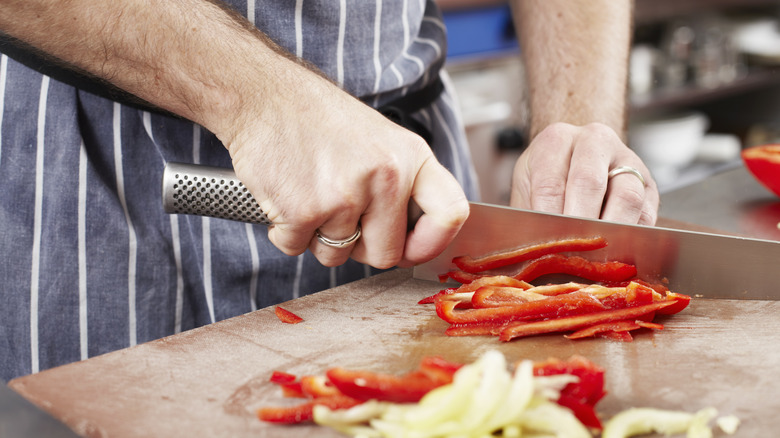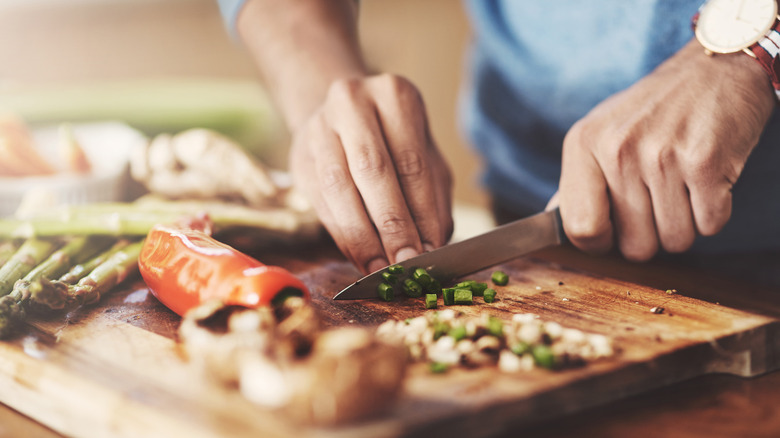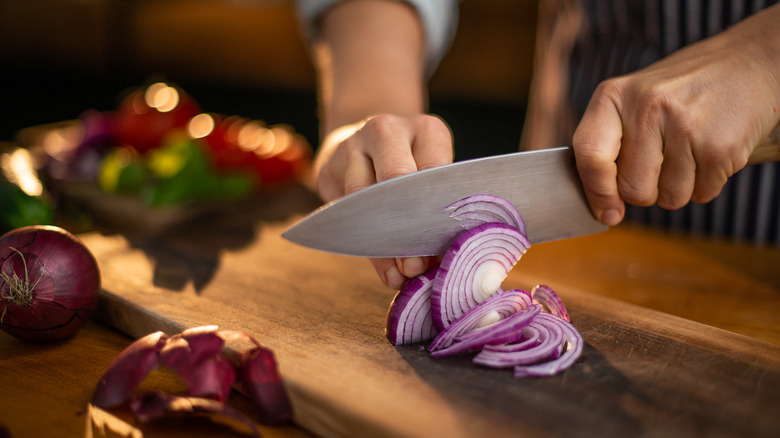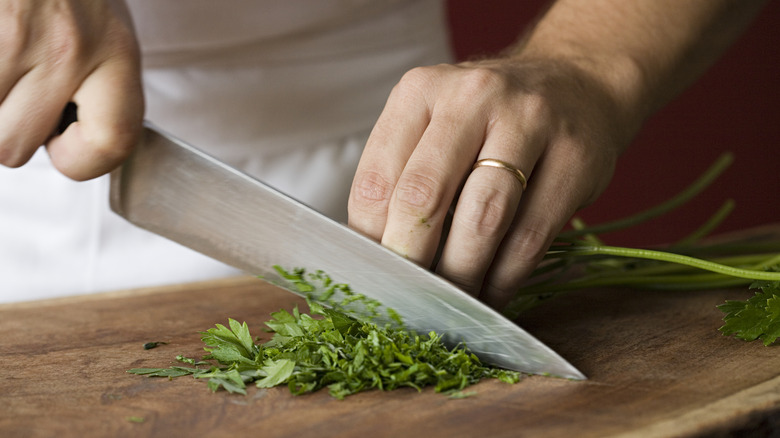The Safest Way To Hold Your Chef's Knife
When you reach for a kitchen knife, you may instinctively wrap your hand around the handle because, well, that's what handles are for. When it comes to the most efficient grip of a knife to maximize control of your movement, pressure of the cut, and safety, the best place to grab it is a little bit higher up toward the blade. You want to pinch the base of the blade right where it meets the handle with your index finger and thumb and then wrap your remaining fingers around the top of the handle. Whether you are mincing garlic, chiffonading basil, or deboning a chicken, the proper grip of the knife ensures the best precision as well as keeping all of your fingers safe.
Not all knives are created the same. They vary in quality, materials, blade shape, weight, and size. However, all knives are composed of a standard set of parts that make up the blade and handle. The correct spot to hold a knife is the same across any spectrum of its factors.
Why it's important to use the right grip
There are a few reasons why holding a chef's knife correctly is of utmost importance. For starters, you are handling a sharp object and applying force to it, so safety is paramount. Not only could you injure yourself, you could injure anyone in the vicinity or do damage to either your kitchen surfaces or the knife itself. When you use the correct grip, it guarantees the most control of what is essentially a weapon.
Also of importance is the command it will provide over what you are cutting and the speed at which you do it. If you haphazardly grab a knife by the butt of its handle, you're missing out on an exponential amount of precision you can add to each stroke. Slicing and dicing are hard enough skills to master as it is, using an improper grip will make them that much harder to attain.
How to properly hold a knife
There are a lot more parts of the knife than just the handle and blade, and each one is important in its own right. Understanding the anatomy of a standard chef's knife will help you grasp just exactly where to grasp it (pun intended).
The straight edge at the top of the blade is known as the spine, also called its back or ferrule. Where the spine meets the handle is known as the bolster. This is where your grip will be focused. The bolster is a thicker piece of metal that adds weight to maintain a balance between the blade and handle. Well-constructed, high-quality knives have what is known as a tang for added balance. A tang is simply a continuation of metal from the blade through the handle, where a thin line of steel will be visible.
You want to place the index finger and thumb of your dominant hand right at the base of the spine at the bolster. As you wrap your remaining three fingers around the top of the handle, the curved knuckle of your index finger will rest along the outside flat edge of the blade. Your thumb will rest on the inner flat edge of the blade. While it may seem intimidating to be so close to the razor sharp edge, it is ultimately the safest hold and best way to maintain agency over the movements of the knife. Think of it as a chokehold of the blade.
What to do with your other hand
The hand that's not holding the knife has two jobs: to manage and guide whatever it is you are cutting, and more importantly, to stay out of the way of the blade! As such, your non-dominant hand that's guiding what you're cutting should take the shape of a bear claw. Tuck your fingertips and thumb under toward your palm so your knuckles are the first part of your hand that's exposed. This ensures safety and keeps all of your digits intact. If you slip or get overzealous with your slicing, the knife will hit a hard wall at your knuckles with the sharp edge only coming into contact with the cutting board and not your extended fingertips.
From point to handle, the blade consists of three main parts. The tip, including the sharp point and about the first third of the blade, mostly stays anchored in one place while you chop. The underbelly of the blade, known as the curve (closer to the tip) and the cutting edge (the majority of the blade's surface area), are doing most of the work and bearing the brunt of the force of your motion — this is where you want to avoid getting your fingertips anywhere near. As the blade makes a rocking motion while you chop, you want to use that non-dominant hand to maneuver the food under the cutting edge while keeping those digits wrapped up in a claw.



